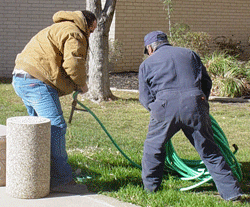By Susan Tallant/managing editor

Even with the recent rain, North Texas needs more than 20 inches of precipitation just to catch up to normal totals for this time of year.
Weather forecasters predict the current drought situation will not end anytime soon.
This prediction does not surprise Mark Schusler, assistant professor of horticulture.
“Fort Worth is horticulture hell,” he said.
Schusler said the climate of Tarrant County is in a transitional zone that is hard on plant life.
According to the USDA Plant Hardiness Zone Map, which shows average annual minimum temperatures, Tarrant County falls right on the border between Zone 7 and Zone 8.
“It is far enough south to experience hot, tropical summers, yet far enough north to experience some severe cold periods in the winter,” Schusler said.
“Tarrant County also lies near the beginning of the line where rainfall severely lessens as you go west yet is easterly enough to get saturating rains,” he said.
Schusler said drought-tolerant plants generally do well in this area unless the season brings an unusual amount of rainfall.
Schusler also said it is hard to predict which plants will do well because the temperatures vary from year to year, but Zone 7 plants usually do better.
“This is the driest winter I have seen,” he said.
Schusler said the best time to replant is in the winter.
“The roots still grow during the winter, so by the time it gets hot, you have a well-established root system,” he said.
But since it has been so dry, he has not been able to complete some personal projects this season.
At home, Schusler suggested watering the lawn before a freeze because when the soil is dry, it shrinks, allowing cold air to get deeper into the surface and drop temperatures further.
Schusler also said to water around the edge of the house to prevent foundation problems.
“It is important to keep even moisture levels around the house,” he said.
Sandy soils need about 20 minutes of watering every week or every other week this time of year. Clay soils need a little more water because clay holds more, but can shrink and swell more than sandy soils.
Thomas VanOver, NW Campus water supervisor, said his department has been making changes by replacing grass near the campus with rye and watering more often near the campus because of the fire danger.
“We are moving ahead with drought tolerant plants, shrubs and grass installations to be better stewards of our water resource,” he said.
The NW Campus water resource is Marine Creek Lake, located near the campus.
David Waldrop, South Campus plant superintendent, said his lead grounds person uses a lot of natural native plants that are very drought tolerant.
But plants are not the problem.
“We have had numerous water main breaks since the summer due to the weather,” he said.
Waldrop said the campus is in the process of getting reengineered to replace water mains to help with breakage.
Students interested in learning more about plant care or landscape design should consider taking a course in horticulture. HALT 1301, Principles of Horticulture, provides an overview of the horticulture industry and introduces students to various careers available in the field.
Some of the students who have graduated from the horticulture program have worked in landscaping for Fort Worth Botanic Garden, Hollywood Hotel, cruise lines and Mary Kay Cosmetics.
